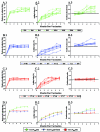Discerning an effective balance between equine infectious anemia virus attenuation and vaccine efficacy
- PMID: 15708986
- PMCID: PMC548432
- DOI: 10.1128/JVI.79.5.2666-2677.2005
Discerning an effective balance between equine infectious anemia virus attenuation and vaccine efficacy
Abstract
Among the diverse experimental vaccines evaluated in various animal lentivirus models, live attenuated vaccines have proven to be the most effective, thus providing an important model for examining critical immune correlates of protective vaccine immunity. We previously reported that an experimental live attenuated vaccine for equine infectious anemia virus (EIAV), based on mutation of the viral S2 accessory gene, elicited protection from detectable infection by virulent virus challenge (F. Li et al., J. Virol. 77:7244-7253, 2003). To better understand the critical components of EIAV vaccine efficacy, we examine here the relationship between the extent of virus attenuation, the maturation of host immune responses, and vaccine efficacy in a comparative study of three related attenuated EIAV proviral vaccine strains: the previously described EIAV(UK)DeltaS2 derived from a virulent proviral clone, EIAV(UK)DeltaS2/DU containing a second gene mutation in the virulent proviral clone, and EIAV(PR)DeltaS2 derived from a reference avirulent proviral clone. Inoculations of parallel groups of eight horses resulted in relatively low levels of viral replication (average of 10(2) to 10(3) RNA copies/ml) and a similar maturation of EIAV envelope-specific antibody responses as determined in quantitative and qualitative serological assays. However, experimental challenge of the experimentally immunized horses by our standard virulent EIAV(PV) strain by using a low-dose multiple exposure protocol (three inoculations with 10 median horse infective doses, administered intravenously) revealed a marked difference in the protective efficacy of the various attenuated proviral vaccine strains that was evidently associated with the extent of vaccine virus attenuation, time of viral challenge, and the apparent maturation of virus-specific immunity.
Figures







Similar articles
-
A live attenuated equine infectious anemia virus proviral vaccine with a modified S2 gene provides protection from detectable infection by intravenous virulent virus challenge of experimentally inoculated horses.J Virol. 2003 Jul;77(13):7244-53. doi: 10.1128/jvi.77.13.7244-7253.2003. J Virol. 2003. PMID: 12805423 Free PMC article.
-
Immune suppression of challenged vaccinates as a rigorous assessment of sterile protection by lentiviral vaccines.Vaccine. 2007 Jan 15;25(5):834-45. doi: 10.1016/j.vaccine.2006.09.040. Epub 2006 Sep 22. Vaccine. 2007. PMID: 17023099 Free PMC article.
-
Serological method using recombinant S2 protein to differentiate equine infectious anemia virus (EIAV)-infected and EIAV-vaccinated horses.Clin Diagn Lab Immunol. 2004 Nov;11(6):1120-9. doi: 10.1128/CDLI.11.6.1120-1129.2004. Clin Diagn Lab Immunol. 2004. PMID: 15539516 Free PMC article.
-
Equine Infectious Anemia Virus (EIAV): what has HIV's country cousin got to tell us?Vet Res. 2004 Jul-Aug;35(4):485-512. doi: 10.1051/vetres:2004020. Vet Res. 2004. PMID: 15236678 Review.
-
EIAV envelope diversity: shaping viral persistence and encumbering vaccine efficacy.Curr HIV Res. 2010 Jan;8(1):81-6. doi: 10.2174/157016210790416398. Curr HIV Res. 2010. PMID: 20210783 Review.
Cited by
-
Pathogenic Correlates of Simian Immunodeficiency Virus-Associated B Cell Dysfunction.J Virol. 2017 Nov 14;91(23):e01051-17. doi: 10.1128/JVI.01051-17. Print 2017 Dec 1. J Virol. 2017. PMID: 28931679 Free PMC article.
-
Dynamic evolution of antibody populations in a rhesus macaque infected with attenuated simian immunodeficiency virus identified by surface plasmon resonance.J Med Primatol. 2006 Aug;35(4-5):248-60. doi: 10.1111/j.1600-0684.2006.00173.x. J Med Primatol. 2006. PMID: 16872288 Free PMC article.
-
Epitope shifting of gp90-specific cellular immune responses in EIAV-infected ponies.Vet Immunol Immunopathol. 2014 Oct 15;161(3-4):161-9. doi: 10.1016/j.vetimm.2014.08.001. Epub 2014 Aug 10. Vet Immunol Immunopathol. 2014. PMID: 25176006 Free PMC article.
-
Protective efficacy of centralized and polyvalent envelope immunogens in an attenuated equine lentivirus vaccine.PLoS Pathog. 2015 Jan 8;11(1):e1004610. doi: 10.1371/journal.ppat.1004610. eCollection 2015 Jan. PLoS Pathog. 2015. PMID: 25569288 Free PMC article.
-
Immunoprophylaxis against important virus disease of horses, farm animals and birds.Vaccine. 2009 Mar 13;27(12):1797-1810. doi: 10.1016/j.vaccine.2008.12.063. Vaccine. 2009. PMID: 19402200 Free PMC article. Review.
References
-
- Bogers, W. M., C. Cheng-Mayer, and R. C. Montelaro. 2000. Developments in preclinical AIDS vaccine efficacy models. AIDS 14:S141-S145. - PubMed
-
- Coggins, L., and N. L. Norcross. 1970. Immunodiffusion reaction in equine infectious anemia. Cornell Vet. 60:330-335. - PubMed
-
- Cole, K. S., J. L. Rowles, B. A. Jagerski, M. Murphey-Corb, T. Unangst, J. E. Clements, J. Robinson, M. S. Wyand, R. C. Desrosiers, and R. C. Montelaro. 1997. Evolution of envelope-specific antibody responses in monkeys experimentally infected or immunized with simian immunodeficiency virus and its association with the development of protective immunity. J. Virol. 71:5069-5079. - PMC - PubMed
-
- Cole, K. S., J. L. Rowles, M. Murphey-Corb, J. E. Clements, J. Robinson, and R. C. Montelaro. 1997. A model for the maturation of protective antibody responses to SIV envelope proteins in experimentally immunized monkeys. J. Med. Primatol. 26:51-58. - PubMed
Publication types
MeSH terms
Substances
Grants and funding
LinkOut - more resources
Full Text Sources
Research Materials

